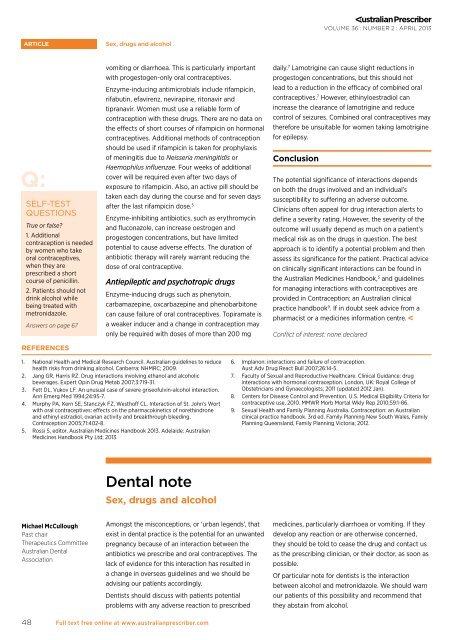Sex, drugs and alcohol - Australian Prescriber
Sex, drugs and alcohol - Australian Prescriber
Sex, drugs and alcohol - Australian Prescriber
Create successful ePaper yourself
Turn your PDF publications into a flip-book with our unique Google optimized e-Paper software.
VOLUME 36 : NUMBER 2 : APRIL 2013<br />
article<br />
<strong>Sex</strong>, <strong>drugs</strong> <strong>and</strong> <strong>alcohol</strong><br />
Self-test<br />
questions<br />
True or false?<br />
1. Additional<br />
contraception is needed<br />
by women who take<br />
oral contraceptives,<br />
when they are<br />
prescribed a short<br />
course of penicillin.<br />
2. Patients should not<br />
drink <strong>alcohol</strong> while<br />
being treated with<br />
metronidazole.<br />
Answers on page 67<br />
References<br />
vomiting or diarrhoea. This is particularly important<br />
with progestogen-only oral contraceptives.<br />
Enzyme-inducing antimicrobials include rifampicin,<br />
rifabutin, efavirenz, nevirapine, ritonavir <strong>and</strong><br />
tipranavir. Women must use a reliable form of<br />
contraception with these <strong>drugs</strong>. There are no data on<br />
the effects of short courses of rifampicin on hormonal<br />
contraceptives. Additional methods of contraception<br />
should be used if rifampicin is taken for prophylaxis<br />
of meningitis due to Neisseria meningitidis or<br />
Haemophilus influenzae. Four weeks of additional<br />
cover will be required even after two days of<br />
exposure to rifampicin. Also, an active pill should be<br />
taken each day during the course <strong>and</strong> for seven days<br />
after the last rifampicin dose. 5<br />
Enzyme-inhibiting antibiotics, such as erythromycin<br />
<strong>and</strong> fluconazole, can increase oestrogen <strong>and</strong><br />
progestogen concentrations, but have limited<br />
potential to cause adverse effects. The duration of<br />
antibiotic therapy will rarely warrant reducing the<br />
dose of oral contraceptive.<br />
Antiepileptic <strong>and</strong> psychotropic <strong>drugs</strong><br />
Enzyme-inducing <strong>drugs</strong> such as phenytoin,<br />
carbamazepine, oxcarbazepine <strong>and</strong> phenobarbitone<br />
can cause failure of oral contraceptives. Topiramate is<br />
a weaker inducer <strong>and</strong> a change in contraception may<br />
only be required with doses of more than 200 mg<br />
daily. 7 Lamotrigine can cause slight reductions in<br />
progestogen concentrations, but this should not<br />
lead to a reduction in the efficacy of combined oral<br />
contraceptives. 7 However, ethinyloestradiol can<br />
increase the clearance of lamotrigine <strong>and</strong> reduce<br />
control of seizures. Combined oral contraceptives may<br />
therefore be unsuitable for women taking lamotrigine<br />
for epilepsy.<br />
Conclusion<br />
The potential significance of interactions depends<br />
on both the <strong>drugs</strong> involved <strong>and</strong> an individual’s<br />
susceptibility to suffering an adverse outcome.<br />
Clinicians often appeal for drug interaction alerts to<br />
define a severity rating. However, the severity of the<br />
outcome will usually depend as much on a patient’s<br />
medical risk as on the <strong>drugs</strong> in question. The best<br />
approach is to identify a potential problem <strong>and</strong> then<br />
assess its significance for the patient. Practical advice<br />
on clinically significant interactions can be found in<br />
the <strong>Australian</strong> Medicines H<strong>and</strong>book, 5 <strong>and</strong> guidelines<br />
for managing interactions with contraceptives are<br />
provided in Contraception: an <strong>Australian</strong> clinical<br />
practice h<strong>and</strong>book 9 . If in doubt seek advice from a<br />
pharmacist or a medicines information centre.<br />
Conflict of interest: none declared<br />
1. National Health <strong>and</strong> Medical Research Council. <strong>Australian</strong> guidelines to reduce<br />
health risks from drinking <strong>alcohol</strong>. Canberra: NHMRC; 2009.<br />
2. Jang GR, Harris RZ. Drug interactions involving ethanol <strong>and</strong> <strong>alcohol</strong>ic<br />
beverages. Expert Opin Drug Metab 2007;3:719-31.<br />
3. Fett DL, Vukov LF. An unusual case of severe griseofulvin-<strong>alcohol</strong> interaction.<br />
Ann Emerg Med 1994;24:95-7.<br />
4. Murphy PA, Kern SE, Stanczyk FZ, Westhoff CL. Interaction of St. John’s Wort<br />
with oral contraceptives: effects on the pharmacokinetics of norethindrone<br />
<strong>and</strong> ethinyl estradiol, ovarian activity <strong>and</strong> breakthrough bleeding.<br />
Contraception 2005;71:402-8.<br />
5. Rossi S, editor. <strong>Australian</strong> Medicines H<strong>and</strong>book 2013. Adelaide: <strong>Australian</strong><br />
Medicines H<strong>and</strong>book Pty Ltd; 2013.<br />
6. Implanon: interactions <strong>and</strong> failure of contraception.<br />
Aust Adv Drug React Bull 2007;26:14-5.<br />
7. Faculty of <strong>Sex</strong>ual <strong>and</strong> Reproductive Healthcare. Clinical Guidance: drug<br />
interactions with hormonal contraception. London, UK: Royal College of<br />
Obstetricians <strong>and</strong> Gynaecologists; 2011 (updated 2012 Jan).<br />
8. Centers for Disease Control <strong>and</strong> Prevention. U.S. Medical Eligibility Criteria for<br />
contraceptive use, 2010. MMWR Morb Mortal Wkly Rep 2010;59:1-86.<br />
9. <strong>Sex</strong>ual Health <strong>and</strong> Family Planning Australia. Contraception: an <strong>Australian</strong><br />
clinical practice h<strong>and</strong>book. 3rd ed. Family Planning New South Wales, Family<br />
Planning Queensl<strong>and</strong>, Family Planning Victoria; 2012.<br />
Dental note<br />
<strong>Sex</strong>, <strong>drugs</strong> <strong>and</strong> <strong>alcohol</strong><br />
Michael McCullough<br />
Past chair<br />
Therapeutics Committee<br />
<strong>Australian</strong> Dental<br />
Association<br />
Amongst the misconceptions, or ‘urban legends’, that<br />
exist in dental practice is the potential for an unwanted<br />
pregnancy because of an interaction between the<br />
antibiotics we prescribe <strong>and</strong> oral contraceptives. The<br />
lack of evidence for this interaction has resulted in<br />
a change in overseas guidelines <strong>and</strong> we should be<br />
advising our patients accordingly.<br />
Dentists should discuss with patients potential<br />
problems with any adverse reaction to prescribed<br />
medicines, particularly diarrhoea or vomiting. If they<br />
develop any reaction or are otherwise concerned,<br />
they should be told to cease the drug <strong>and</strong> contact us<br />
as the prescribing clinician, or their doctor, as soon as<br />
possible.<br />
Of particular note for dentists is the interaction<br />
between <strong>alcohol</strong> <strong>and</strong> metronidazole. We should warn<br />
our patients of this possibility <strong>and</strong> recommend that<br />
they abstain from <strong>alcohol</strong>.<br />
48<br />
Full text free online at www.australianprescriber.com
















